Quality beer does not make itself. Even 200 years ago it was understood that brewing requires a skilled, dedicated brewmaster. With the help of its brewmasters, Sinebrychoff has developed from a small 19th century brewery into a successful modern company.
Journalist Jussi Rokka has compiled important information on these brewmasters, who were – and still are – driven by the passion of brewing perfect beer.
Starting small
1819–1847
Nikolai, a young businessman
The year is 1819. The merchant Nikolai Sinebrychoff, who has settled in the Sveaborg or Viapori garrison (nowadays Suomenlinna) is only 30 years old, but has already built a sizeable trading house. In just over ten years, beginning with the brickworks and sawmill inherited from his father Pjotr (Peter), he creates a trade and construction business operating in the western parts of the Russian Empire at an increasingly larger scale. lll
1819
Nikolai Sinebrychoff requests a brewery site from the Helsinki Imperial New Construction Committee. On 13 October 1819 the committee responds by allocating a brewery plot outside the built-up area of the town on the Sandviken (Hietalahti) shore.
Nikolai’s entire family helps to expand the business; his younger brother Ivan handles affairs in Russia. For a while he lives in the family’s hometown of Gavrilov with the youngest brothers Pavel (Paul), Mihail, Andreas (Andrean) and Peter who also wish to become merchants. Peter dies young, but the others later acquire their bourgeoisie rights in Finland. They have three sisters, and the family does its best to marry them into prestigious merchant families in Gavrilov. Networks are important.
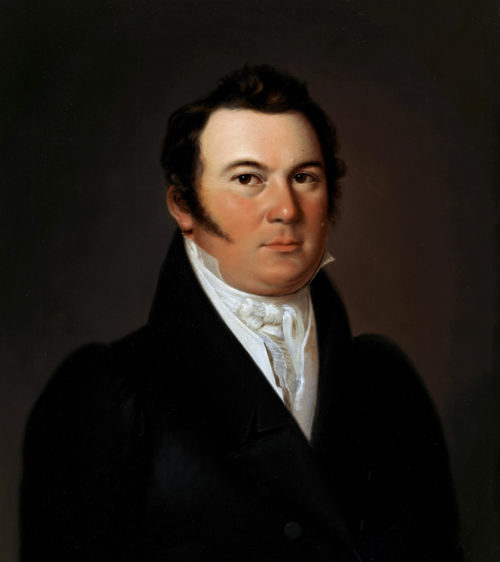
Bluebellies
The Sinebrychoff family belongs to a lineage already renowned in the 17th century as outstanding merchants. The surname Sinebrjuhov/Sinebrjukov/Sinebrychoff, freely translated as “bluebellied”, reveals this. In old Russia, the coloured wide sash belonging to the tradesman’s attire indicates the status of a businessman, and blue is a sign of the highest rank.
Exclusive rights at the outskirts of the city
Nikolai Sinebrychoff’s business tasks in Viapori include acting as a “marketent”, or garrison tradesman. Nikolai runs a shop, pubs, and a brewery on the islands. For a few years he has also owned a distillery in the town of Helsingfors on the mainland, as well as a shop selling groceries and beer. Now an opportunity to expand even further arises when the town council decides to auction off the exclusive rights to manufacture beer commercially.
Nikolai Sinebrychoff acquires the rights and a permit to build a new brewery outside the built-up town area on the Sandviken (Hietalahti) shore.
After the Hietalahti plot has been measured and documented, a two storey wooden house is moved to the site for office and living purposes. The foundation for a new brewery, a 4.5 metre-high stone wall, is rising rapidly, even though the cost of the stones continues to be debated between Sinebrychoff and the town for a few more years.
In November 1822, Sinebrychoff buys the Österberg brewery in an estate auction, along with a distillery from Vanhakaupunki (“Old Town”) with buildings and equipment. As far as we know, brewing is not initialised at that site because his brewery in Hietalahti is nearing completion at the time of the auction. Brewing operations in Viapori, however, have continued the entire time.

Only the best brewmasters
To start up the brewery and supervise the brewing itself, Sinebrychoff decides to hire an experienced brewmaster from abroad.
August Putzscher is the first Sinebrychoff brewmaster found in surviving written sources. His brewmaster’s contract is dated 31 August 1820. Apparently from Saxony, Putzscher had also been similarly employed in Sweden; he works at the Sinebrychoff brewery for almost the entire 1820s. In early 1828 he announces his transfer elsewhere in a newspaper. In July of that same year his name appears on a ship’s passenger list in Turku, indicating that his new job was probably in Sweden.
Undertecknad anhåller wänskapligast, att hwar och en som till mig blifwit något skyldig under den tid jag förestått Hr N. Sinebrychoffs Bryggeri, behagar inom den 1 nästk. Mars med mig träda I Liqwid, emedan mitt wistande här å orten vid nämnde tid upphör. Helsingfors den 15 Jan. 1828. Aug. Putzscher, Bryggmästare. (Finlands Allmänna Tidning, 24 January 1828).
Brewmaster August Putzscher thus communicates that he is moving away, and asks those indebted to him to settle their accounts by the 1st of March.
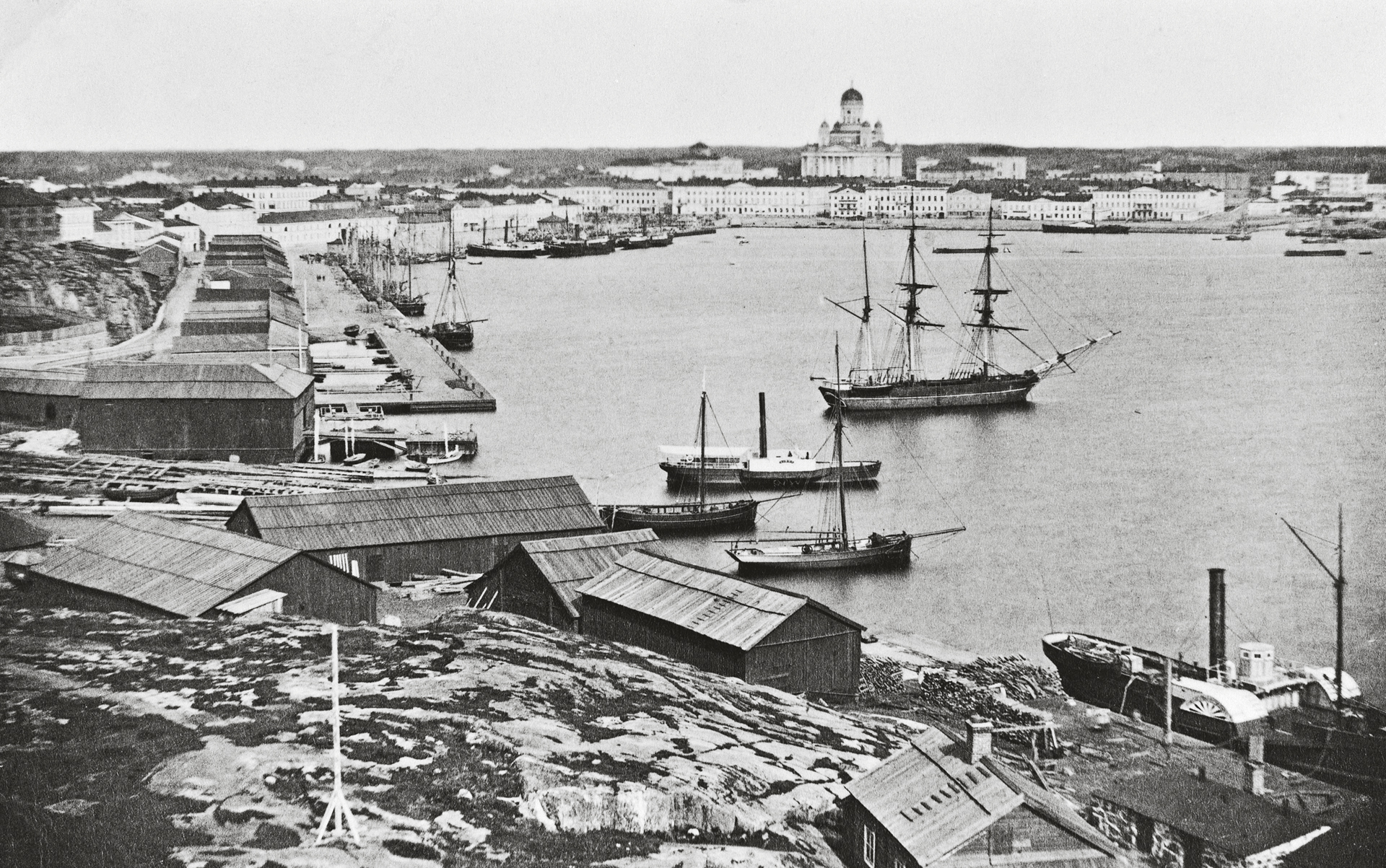
Growth into a capital city
Helsinki has been the capital of the Grand Duchy of Finland since 1812, but only the aftermath of the Great Fire of Turku in 1827, and the subsequent transfer of the Imperial Academy of Turku to Helsinki, spark the growth of the town.
Helsinki City Museum
Reinhold Wennberg is August Putzscher’s apprentice at Sinebrychoff for several years. His employment contract with the Swede Wennberg is dated 4 December 1822. Wennberg returns to his home country in 1825 and appears in the church records of Stockholm’s Klara parish. It appears that his brewing career continues successfully; in 1831 he owns a house on Drottninggatan.
1824–1825
In 1824 the Hietalahti brewery employs two brewmasters and five hired hands; in 1825 one master, one journeyman and three employees.
“I brew the best beer”
Gottfried Putzscher, August Putzscher’s brother, has been a journeyman at the Hietalahti brewery since 1826. On 1 January 1829, Gottfrid and Nikolai Sinebrychoff sign a contract specifying quality as the top priority. Putzscher promises to “make the best brew, corresponding in quality with the best bread available in the area”.
The Undersigned, Merchant Nikolai Sinebrychoff and Master Brewer Putzscher together agree:
First. I, Gottfrid Putzscher, take upon brewing at Mr. Sinebrychoff’s brewery in Helsingfors.
Second. For the said beer I make grain malt of a quality required to brew the best beer.
Third. The aforesaid malts I brew into the best beer, corresponding in quality the best bread available in the area.
Fourth. I, Putzscher commit to keeping the Brewery in working order, as well as the vessels therein, and I do not allow for any exception hereto, for which purpose he, Mr. Sinebrychoff, shall arrange the required number of employees, who have to obey me, Putzscher, in everything.
Fifth. If I, Putzscher, deem it appropriate to give a new order to the benefit of him, Mr Sinebrychoff, it is my duty to inform him of this, and he shall approve or reject the order – if he, Sinebrychoff, rejects it and in consequence may suffer losses, he shall not lay any demands on me.
Sixth. Mr. Sinebrychoff commits to giving Him, Putzscher, in all appearing cases such help that Mr Sinebrychoff can give.
Seventh. I, Gottfrid Putzscher, am responsible for protecting the Brewery Buildings of any accident that might be caused by fire (God forbid), and closely oversee both the furnaces and Employees, that they are not careless with fire.
Eighth. If either of us is for any part discontented, he may terminate this agreement, but only by giving notice about it six months in advance. Before six months of the notice has passed, the contract does not cease to bind either contract party.
Ninth. For the above written, Gottfrid Putzscher receives from Mr. Sinebrychoff an annual salary of One Thousand five hundred Rubles in Notes, which salary shall be paid quarterly; he shall receive a furnished apartment including heating and lighting thereto, as well as a required amount of Beer for his own use, and a jug of spirits a week.
Tenth. In witness whereof this has been executed in Two identical copies, of which the parties shall each keep one for their own, duly signed.
Helsinki 1st January 1829
Merchant Nikolai Sinebrychoff Gottfrid Putzscher
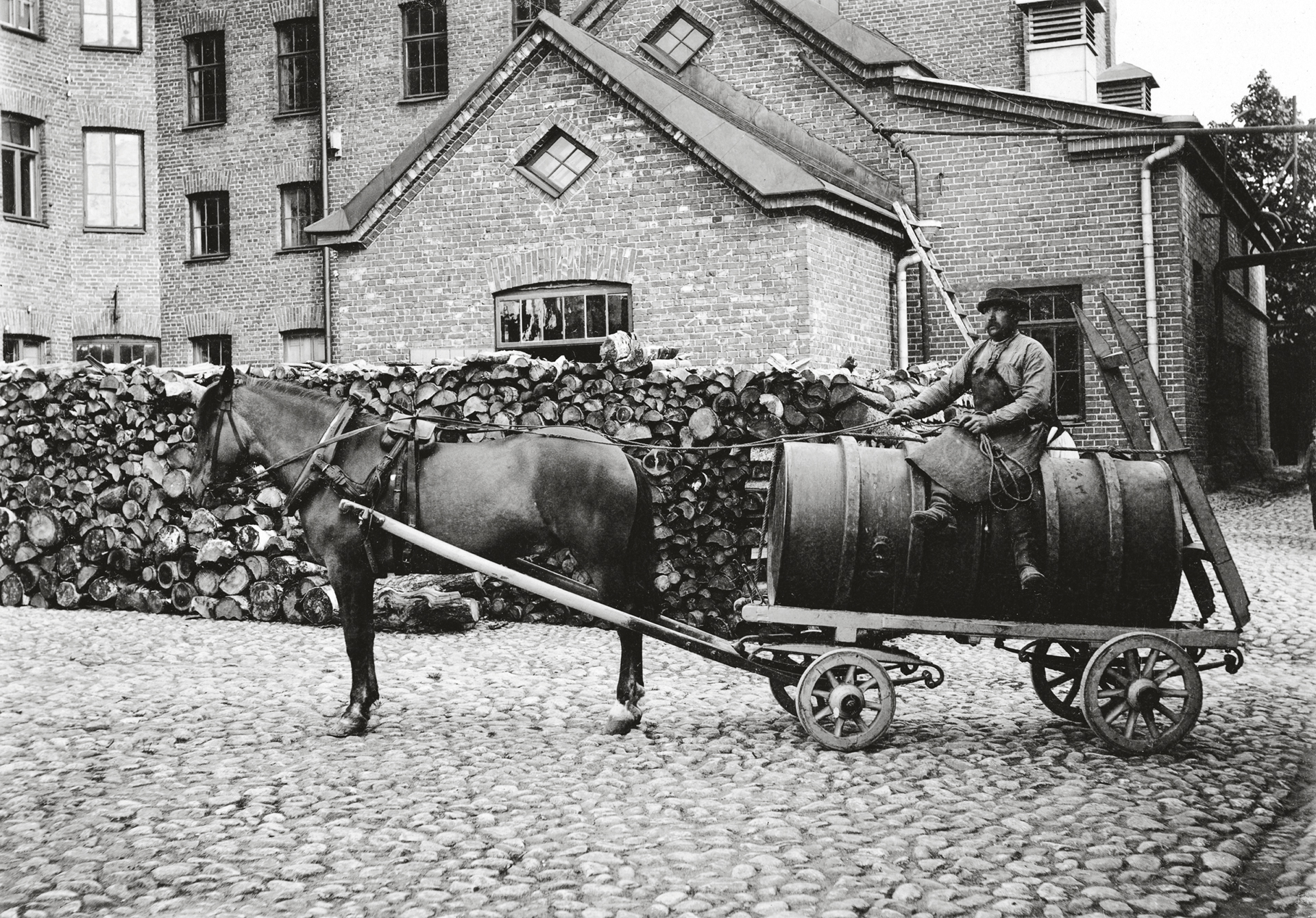
Extra income from mash leftovers
The sale of mash is not mentioned in the 1829 contract between Nikolai Sinebrychoff and brewmaster Gottfried Putzscher (page 12), but brewmasters are often allowed to sell spare mash leftovers on their own account. A portion of the leftovers might also be included with the brewery horses’ fodder, and according to old brewery wisdom, the master will observe from the horses’ behaviour how well the previous mashing has succeeded. If the yield is good, with most sugars washed in the wort, the horses are calm as they are usually. If the horses become visibly overstimulated, the wort had become too thin.
The brewmaster’s shady businesses
The distillery master Christian Friedrich Eichstedt, born in Stettin in 1777, is Nikolai Sinebrychoff’ shop steward and master at the distillery. Eichstedt has managed the profitable distillery’s work since 1819. When necessary, he also works as brewmaster.
There has been a need because not all brewmaster recruitments are successful. The first example is Gottfrid Putzscher; he remains the head brewer at the Hietalahti brewery for only a year, and disappears from the records before the 1830 census registration.
Carl Preis is the brewmaster at the Hietalahti brewery in early 1830. He is also entrepreneurial outside the brewery, and takes it upon himself to perform courier services for wealthy merchants and accommodate travellers.
Something goes wrong, however, in Preis’ businesses. In the spring of 1833, the provincial governor of Uusimaa discontinues his courier services. Preis flees the country through Turku, leaving behind unpaid debts and unresolved civil lawsuits. The plot and buildings he has acquired are sold at an auction, and as late as 1835 there is a notice in the Official Journal for Preis to appear in the kämnärsrätt (lower town court) to respond to a claim presented by his former neighbour, the baker Möller.
1830
The Hietalahti brewery’s production volumes increase. In the early 1830s, the combined brewery and distillery recently transferred to the site employ one brewmaster, one distillery master, two bookkeepers, 31 hired hands, and two maids.
The empire expands
During these years Nikolai Sinebrychoff has other things on his mind besides the comings and goings of brewmasters. His construction business operates widely; now he is contracting garrison buildings in the Kamppi area of Helsinki for the Russian Army.
Johan Friedrich Stier, a close business partner of Nikolai Sinebrychoff and head of the merchant family Stier, dies in 1830. Stier’s widow Ulrika Ahlström moves into Nikolai Sinebrychoff’s household with her child. They do not marry, but their relationship is so close that future generations regard Stier’s daughter Natalia as Nikolai’s own.

1835
The brewery is going strong, even if a few brewmaster recruitments have been unsuccessful. An 1835 census table lists 25 employees at the Hietalahti brewery.
After arriving in Hietalahti in 1835, the new brewmaster W. Nachtigall proves to be a more successful recruitment than his predecessors. Nachtigall and his assistant, the barrel master Fredric Svettkoff, oversee the brewing for almost a decade. Originally from Prussia, Nachtigall dies in Helsinki in the mid-1840s.
A steam engine is introduced at the Hietalahti distillery in the early 1840s. Even though the city registry office limits the distilling period to a few months per year, distillery operations remain highly productive.
1840s
The brewery’s growth has slowed, but there are 30 employees at the end of the decade.
Cheers in the Bavarian style!
1848–1864
After Nikolai
In January 1848, Nikolai Sinebrychoff dies in Tver, Russia during a business trip. Nikolai’s brother Ivan first assumes control of the entire business. In 1852 the Sinebrychoff business is divided, with Ivan concentrating on businesses in Russia and Paul overseeing the Helsinki operations.
Even before the estate inventory, the sisters and their husbands sign a contract accepting the redistribution of Nikolai’s fortune to his brothers Ivan and Paul. The justification is that the sisters did not contribute to the wealth of the trading house, but lived at its expense.
At over fifty years of age, Paul rolls up his sleeves, and under his supervision the brewery becomes a major facility even on the Nordic scale.

1853
53 employees work in Hietalahti. New construction projects are also necessary beginning in the early 1850s; additional space is needed for production, warehouses, and employee housing. The brewery site also begins to expand to eventually include almost the entire area now bordered by the Bulevardi, Hietalahdenranta, Punavuorenkatu, Kivenhakkaajankatu, Iso Roobertinkatu, and Albertinkatu streets.
At the beginning of Paul Sinebrychoff’s reign Erik Gustav Nilsson works as brewmaster. An 1848 address calendar shows him living at Bulevardi 40. He has probably arrived at Hietalahti from Sweden in 1843. In late 1848, Nilsson becomes responsible for Sinebrychoff’s distillery when the master Eichstedt resigns from working life at over 70 years of age, later living to the respectable age of 87 in Helsinki.
Nilsson later moves to the villa district in Töölö, and works at the Thölö Bryggeri. This facility changes ownership as well as its name several times, but Nilsson stays.
Brewmaster’s equipments
In the mid-1800s, brewing is firmly based on the experiences of former generations and the brewmaster’s ability to apply them. The brewery now uses several devices – including a thermometer and hydrometer, as well as various charts – to monitor beer quality. The significance of malting and mashing as it pertains to the conversion of the grain’s starch into sugars, as well as the yeast’s work in transforming sugars into alcohol, is known on the practical level, but the microbiological process of brewing still remains unknown until studies published by Louis Pasteur in the 1860s and 1870s pave the way for our present-day knowledge and laboratory work.
From Swede to German
The next brewmaster is Adam Julius Adolf Arenander. Born in Stockholm on 9 September 1822 and educated in the family brewery, he starts working at the Hietalahti brewery in November 1848. Records list him a brewery accountant and brewmaster. Paul Sinebrychoff signs a brewmaster’s contract for four and a half years with Arenander on 5 January 1853. The archived copy reveals, however, that the contract was terminated only a few months later on 13 May 1853.
A Swedish subject, Arenander receives permission to leave Helsinki in October 1853. Church registers reveal that Arenander’s private life is also in turmoil; he moves to Tampere where he is recorded as living with the accountant Reinhold Bäck’s widow Katharina and her son Otto Bäck, born on 27 April 1853. The couple is married on 10 February 1856 in Tampere, and according to church registers, the son Otto becomes Adam Arenander’s foster child. During that period, Arenander is possibly employed at J.F. Lönnholz’s brewery in Hämeenlinna.
The family moves to Tammisaari in 1858, where Arenander works at the Ekenäs Ölbryggeri Bolag at least as an accountant. During 1862-1866, the family lives in Stockholm in the household of Adam’s brother, the brewmaster Olof Arenander, after which he moves back to Tammisaari. There the C. F. Hultmans Porterfabrik employs him as brewmaster, but when the Porter- och Ölbryggeri AB i Ekenäs is founded in 1873 to compete with the former, he goes to work for the new company. Adam Arenander dies on 14January 1883 in Tammisaari, still a Swedish citizen.
According to surviving written fragments, Arenander seems eager to litigate. Frequent job changes and earlier events in Sweden may indicate an irascible personality.
The termination of his employment at Hietalahti brewery may nevertheless have been primarily influenced by Paul Sinebrychoff’s decision, after he took the reins at the brewery, to make a new type of so-called Bavarian beer made with low fermentation yeast. The old-school top yeast quality is now referred to as “Swedish” and its production decreases year by year.
Brewing in the Bavarian style
In 1860 in Berlin, the book Chemie für Laien (“Chemistry for Laymen”) devotes more than a hundred pages to Bavarian brewing methods. The following overview is based on that description. The reader should keep in mind that the techniques presented correspond to the limited knowledge available at that time.
”The phases of brewing are the malting of grain, preparation of the wort, and fermentation. The goal of malting is to transform the starch into sugars by germinating the grain. When the wort is prepared by mashing, these sugars undergo a phase called diastase, after which the yeast can ferment the resulting liquid into beer.
Rinsing the malt to remove dust and dirt is usually advisable. Here we find that cats in a malt house are both useful and counterproductive. They do keep mice under control, but they have the nasty habit of defecating in the malt.
The clean malt is crushed into coarse groats before it is moved to the mash tun and mixed with water. The ratio between malt and water is the brewmaster’s trade secret; the aim is to achieve the most desirable end result as economically as possible.
Mashing begins by adding half of the water needed into the malt. The mixture is stirred well while the other half of the water is heated to a boil in the brew kettle. The boiling water is poured into the mash tun thus heating the mash to a temperature of 35 degrees Celsius. Most of this mixture is scooped into the brew kettle, where it is boiled as soon as possible while mixing the mash. The mash is boiled from 30 minutes to one and a half hours, the exact duration determined by the brewmaster. This is called the first thick mash boil.
The boiling mash is brought back to the mash tun and the entire mass is mixed thoroughly. The temperature now rises to between 45 and 50 degrees. Approximately one-third of the mixture is then boiled in the kettle; this is the second thick mash boil. When the boiled mash has been returned to the mash tun and mixed well into the other mash, its resulting temperature is 60-65 degrees.
The liquid is then taken from under the mash tun strainer into the brew kettle and boiled for 15-30 minutes. This is the third, strainer boil. When the liquid is returned to the mash tun, its temperature rises to 65-70 degrees. The mixture is then stirred well, covered with a lid, and left to sit for two hours. Meanwhile the brew kettle is cleaned.
Two things must be particularly kept in mind when mashing; too short a time is not enough for sugars to form, and too long a time makes the wort sour.
When the bottom valve of the wort tun is then opened, the first liquid obtained is viscous. The thick wort is returned to the mash, but the clear wort is moved to the brew kettle. This first wort produces the actual beer. As the first wort has been separated, the mash can be basted with boiling water. This second wort can be further treated as the first wort, or it can be sold to the poor.
The acquired wort is not yet strong enough, so the water needs to be evaporated. This is why boiling it is essential. The Wort also contains proteins that are deposited at the bottom of the kettle as the beer becomes clearer. The boil is also needed for adding hops. The wort itself is unpleasantly sweet and needs something to make it taste good in the mouth. After experiments carried out with a variety of substances, hops have proven to be the most pleasant and harmless additive. The amount of hops depends on many factors: the quality of malt, the sweetness of the wort, beer drinkers’ habits, and whether the beer will be stored for shorter or longer periods.
After the wort has been sufficiently boiled, it is cooled in a cooling vessel which is a voluminous tray. As a brewery’s production volume increases, more trays are needed. Cooling should take place as quickly as possible so that contact with the air does not spoil the beer. Any cooling period exceeding 12 hours is detrimental; a cool air stream under the cooling tray is thus advisable in warm weather. In winter, beer can be cooled in 2 hours. The target temperature should fall below 10 degrees, preferably 6-7 degrees. In difficult circumstances 20 degrees will suffice but is not recommended unless top yeast brewed beer is being made.
The cooled wort is moved into fermenting vats. The space has to be odourless and extremely clean. The temperature should also be consistently cool. This is why this building has thick walls and plenty of ice upstairs.
A small amount of wort is taken from the brew and the yeast is added. As the mixture begins to bubble, it is mixed well with the wort in the vat. During the first 12 hours this procedure is repeated as many times as is required until foam begins to appear on top of the wort. The foam bubbles are carbon dioxide gas, which is first sensed as a stinging sensation only above the vat, but eventually it flows over the brim and being heavier than air, sinks to the floor. If a dog would now stray into the brewing room, it would soon cease to breathe and die from a lack of oxygen.
After three or four days the fermentation peaks and the yeast begins to sink to the bottom of the vat. The cleared beer is called young or green beer. The foam covering the brew is removed, and the beer is tapped away from the yeast to lager barrels.
The good middle part is taken from the yeast mixture on the bottom of the vat, and then stored in clean, cold water and used for the next batch. Collecting the yeast requires the ability to avoid the slimy top layer and the dead bottom layer. The fermentation vat, including its corners, is then thoroughly cleaned.
Fermentation continues in the storage barrels. The more fully the first fermentation has taken place, the slower is the second fermentation. The degree of fermentation can be ascertained by measuring the weight of wort with a saccharometer before fermentation and after the first fermentation. The brewmaster uses this difference to decide whether the beer will be consumed quickly, or whether it will be left to stabilize longer in storage.”

Prost!
To change the style of production at Hietalahti brewery, a professional familiar with the new methods is needed, preferably from a country south of the Baltic Sea, and optimally from Germany’s Bavarian region. The brewery is under added pressure because the exclusive rights to commercial brewing granted in 1819 and later extended are to end in 1852.
Negotiations with Carl A. Krantz begin. He has learned his brewing skills in Central Europe. Copies of his certificates sent to Paul Sinebrychoff indicate that he comes from Tilsit, where he served as an apprentice in a local brewery. He also presents a certificate confirming his completion of a brewmaster test administered by the Bavarian Royal Investigating Authority in Munich. His previous employment was in Revali (now Tallinn).
The position of brewmaster and its accompanying salary is negotiated with Krantz during the spring of 1853, but a mutual understanding is never reached, nor does Krantz arrive in Hietalahti to brew beer.
Brewmasters’ wage negotiations
Brewmasters are esteemed professionals whose wage negotiations may have been quite complex. Sinebrychoff archives include the employment agreement reached between Carl A. Krantz and the Hietalahti brewery on 4 March 1853. Yet, according to a similarly archived letter dated 7 March 1853, Krantz is still asking Paul Sinebrychoff for further information on the employment offered while stating his own terms:
1) the entitlement to freely buy materials and goods or at least to choose such freely
2) full entitlement to recruit labour to the brewery and especially hire and fire apprentices
3) a request for 100 silver rubles to cover his travel expenses from Revali to Helsinki.
For his part he is ready “according to his master’s wishes, to brew all existing types of beer, look after the economies of the operations, keep books and calculations, handle money etc.”, all of this at his own risk.
Krantz also promises that the master’s possible losses may be deducted from his own wages, 1,500 silver rubles plus housing and keep. He is ready to begin employment on 15 April.
Apparently the negotiations did not end up as Carl Krantz had hoped for; in the late spring of 1853 another brewmaster begins his employment in the Hietalahti brewery.
At 35 years of age, Johann Kasper Kröckel is already an experienced brewmaster and proficient in Bavarian brewing. Born on 25 July 1818 in Weissenbach, Gmunden district, lower Franken, Kröckel is a member of an established family of brewers. His brothers Ludvig and Adam later work at Sinebrychoff as barrel-makers, and Johann himself has particularly strong links to the Central European brewing sector.
After his journeyman’s period Johann Kröckel, now a brewmaster, arrives in Mitau (now Jelgava in Latvia), which in 1842 is that country’s first brewer of Bavarian beer. In Mitau he also starts a family with Benigna Elisabeth, a member of the local German community.
In 1846 the couple moves to St. Petersburg, where a newspaper article notes that Kröckel’s beer has achieved a degree of renown with the local gentry, initially only among Germans; at first the Russians do not have an appetite for the Bavarian style. The first two children of the family, Julie and Carl Friedrich Wilhelm, are also born in St. Petersburg.
During his employment in Hietalahti, brewmaster Kröckel’s family resides in a house along the Bulevardi. In 1854 the family grows with the arrival of their daughter Anna. Gustaf is born in 1856 and Georg in 1858, but both die from infant diseases.
The eldest son Carl is also afflicted; in the Helsinki German parish register his name is followed by the marking “Schwachsinnig” indicating that he has a disability. By contrast, the young Anna is energetic and able, and eventually manages Johann’s own businesses.
In Hietalahti, Kröckel is allowed to build the brewery according to Bavarian skills he has mastered. The new wooden two-storey addition contains four wide pans for cooling wort built on poles extending to the upper floor. The ground floor again hosts a large beer tub whose contents are sold to customers bringing their own containers. The malt house also gains more space.
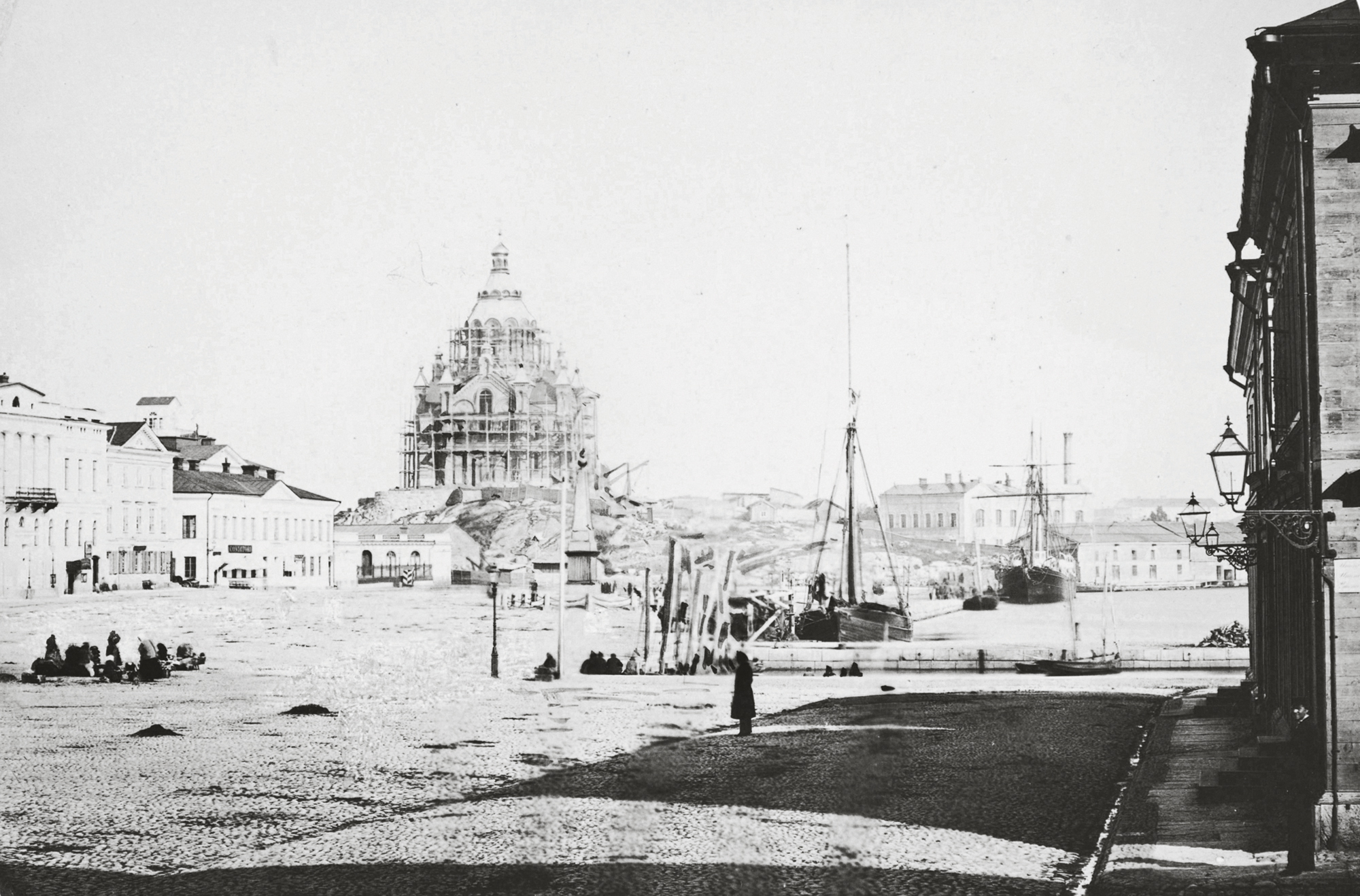
Finland develops, Helsinki urbanises
The mid-1800s are highly eventful in the Grand Duchy of Finland and its capital Helsinki. During the Crimean war, an Anglo-French naval division pays a visit to bombard Viaborg. The Saimaa canal is completed in 1856; that same year Alexander II, the new emperor of Russia, visits Finland. Streets are more frequently paved with stones and lined with gaslights.
In 1860 Finland adopts its own currency, the Finnish markka. It is initially valued at a quarter of the Russian ruble but due to the ruble’s fluctuations, the markka is tied to silver as early as 1865 (one ounce of silver = FMK 94,48).
A railroad is built from Helsinki to Hämeenlinna, and railway traffic begins in early 1862. That same year, the Greek Orthodox Church initiates the construction of the Uspenski Cathedral. Paul Sinebrychoff is a major contributor to the church’s building costs. At a banquet celebrating the Russian Emperor Alexander II’s visit to Helsinki in the summer of 1863, Paul Sinebrychoff is seated at the Emperor’s table. In the autumn of the same year, members of the Finnish gentry convene a parliamentary session for the first time in 54 years.
Uspenski Cathedral under construction in 1862-68. Helsinki City Museum
Competition intensifies, Hietalahti stays on top
Johann Kröckel is responsible for brewing at the Hietalahti brewery for over ten years. Competition is already intensifying during that time; the breakthrough of the new beer style attracts new entrepreneurs to the sector, and more breweries are founded than the market can accommodate. Chronicles indicate that most enterprises have a member of the owner family or a foreigner as a brewmaster; initially there are many Swedes, but the number of German brewmasters increases steadily year by year in all parts of Finland.
Whether it is due to Paul Sinebrychoff’s business acumen or Kröckel’s authentic Bavarian skills, competitors are unable to take a market share from the Hietalahti brew. The budding breweries are also hampered by political circumstances; the Crimean war further complicates the imports of Baltic barley and Central European hops through the Baltic Sea.
To alleviate the bottlenecks resulting from increased production, relief is sought from Viaborg where a portion of the Hietalahti brew is bottled for several years. Quality problems, however, arise. Newspapers report complaints of beer that tastes bitter, or is too watery. Even worms are alleged to have been found in bottled beer.
The newspaper Finlands Allmänna Tidning makes its own contribution to the discussion by inviting university level chemists to analyse different beers; the quality of Sinebrychoff’s beers is found to match that of its Central European counterparts.

1860s
By the early 1860s Sinebrychoff has over 100 employees. The brewery uses four furnace kettles, 30 vats, and a steam engine.
From brewmaster to entrepreneur
New vistas inspire brewmaster Kröckel. In 1864 he leaves Hietalahti to start his own business. He teaches a course on Bavarian brewing in the recently opened agricultural school at the Lauritsala Manor and founds the Södernäs Ölbryggeri brewery on the shore of Vanhankaupunginlahti in Helsinki. Kröckel’s brewery is an eager advertiser in local newspapers, and he also takes his beers to industrial trade fairs in Stockholm and St. Petersburg for medals.
In 1872 Johann Kröckel sells his Södernäs brewery to a group of businessmen. Paul Sinebrychoff participates initially as a minority owner, but later becomes the majority shareholder.
After the sale Kröckel moves the brewing activities now bearing his name outside the town. From the owner of Tali Manor, the nobleman Ramsay, Kröckel rents a plot by Läntinen Viertotie near the Mätäjoki rapids; there he dies of a heart attack on 27 May 1891.
His daughter Anna has married Johan Heinrich Blöcker, formally a master gardener at Sinebrychoff, and they continue the Kröckel brewery operations.
A convivial German
When the long-term successful brewmaster Johann Kasper Kröckel dies in 1891, he is respectfully mentioned in obituaries as the most senior of the brewmasters. The Swedish-language newspaper Hufvudstadsbladet even characterises Kröckel as having been “en tysk av det gamla gemüterliga slaget” (”a convivial old-style German”).
The largest and most modern brewery in Finland
1865–1939
Distillation fades
The Finnish beer market is expanding, but Sinebrychoff’s production volumes remain steady between the mid-1860s and the 1880s; the market share is thus decreasing.
Paul Sinebrychoff decides to renovate the Hietalahti facilities and invest in the distillery. By the 1880s, however, distillation has become less lucrative owing to new legislation. Consequently the company’s operations begin to focus on the brewery.


The hand of the German masters
Johann Leonard Zorn succeeds J. K. Kröckel in Hietalahti in late 1863. Born near Würzburg in Reichenberg on 16 January 1831, his roots are also in Franken – and in beer. His father Johann Philipp was the proprietor of the Würzburger Hofbräuhaus, and his brother Filip, who emigrated to America, is also a brewmaster. Two of Leonard’s sisters, Anna and Margareta, marry German brewmasters and move to the United States. His third sister Babett also sails west with her husband, a German restaurateur. His fourth sister Maria arrives in Finland with her brother, marries Wenzel Drodzak, a master gardener working at Sinebrychoff, and later moves to Norway.
Leonard Zorn arrives in Helsinki from Sweden, where he has been employed at breweries in Gothenburg, Uppsala, and Stockholm. He has a son born out of wedlock with Grudd Anna Andersdotter from Dalarna, but Zorn never sees the child who is raised by the mother’s parents. Grudd Anna does not follow Leonard to Finland, remaining at the Stockholm brewery.
Although Leonard Zorn never officially declares the paternity of his son Anders Leonard who remains in Sweden, he nevertheless begins to financially support the boy’s education. The talented Anders Zorn later becomes one of Sweden the most renowned artists.
There is plenty of work at the brewery, and a distinct malt master, the German Karl Blümel, is hired to run the malt house in 1865. With the onset of the 1870s Zorn begins to renovate the brewery with the latest technologies. During the planning phase, however, Zorn suffers a cerebral haemorrhage and dies on 26 December 1872. The newspapers report the exact time of his death: half past three in the afternoon.
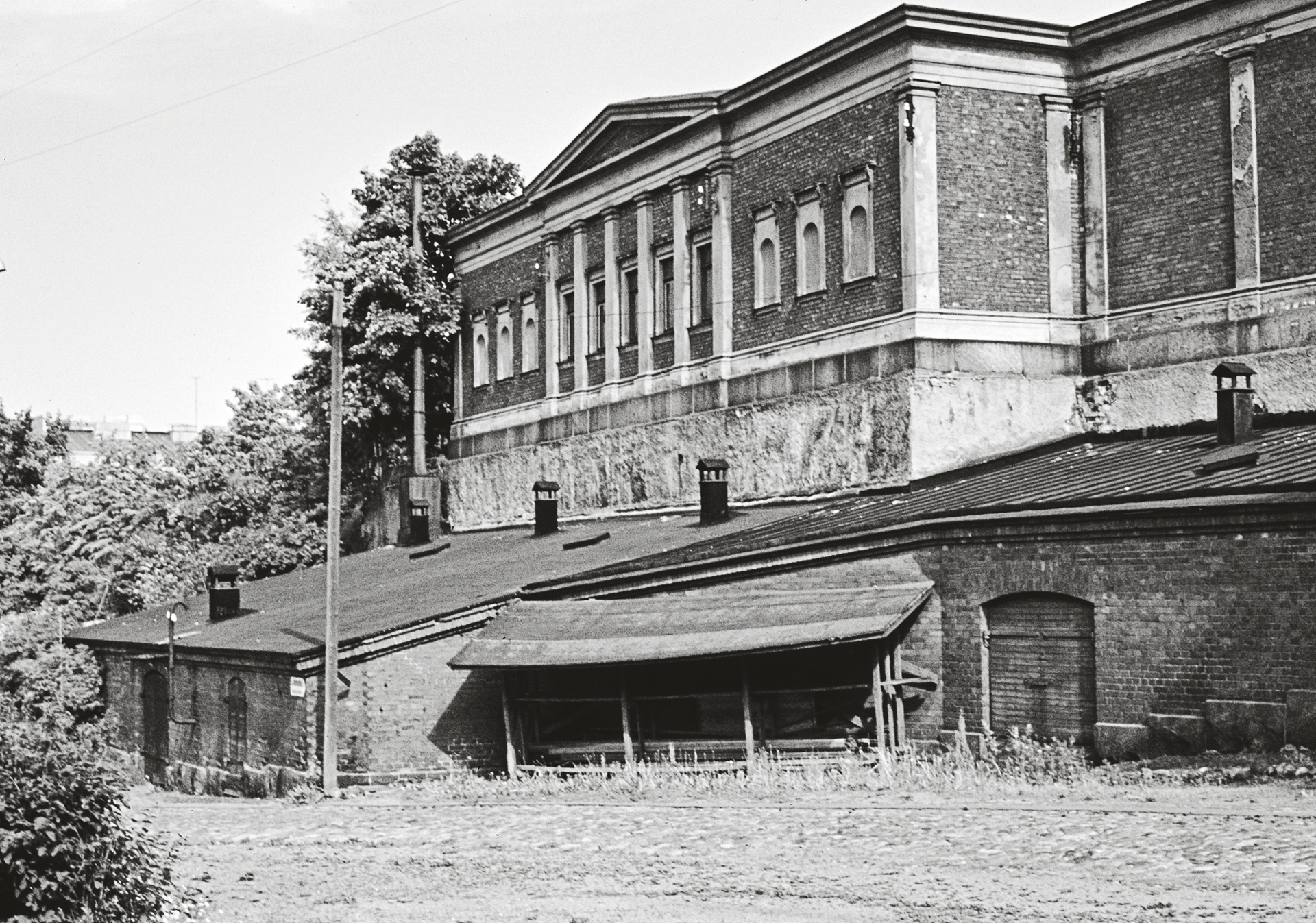
Siberia in Hietalahti
During brewmaster Zorn’s time in the 1860s-1870s, a large storehouse given the name Siberia is built on the Hietalahti plot. A tower structure erected at the south end of the building still remains on the site. The ice cellar is also enlarged.
The Siberia storehouse, 1964. Helsinki City Museum
Heinrich Lehmann becomes Paul Sinebrychoff’s choice for filling the sudden brewmaster vacancy. Lehmann was born in Bavaria in 1832, but he had been working in Sweden for so long that he had applied for and received Swedish citizenship. Census lists indicate that he moved to a house along Bulevardi with his daughter Hanni, born in Nuremberg in 1862, and the damsel Emilie Kristina Sabelström, born in Kalmar in 1839.
Lehmann finalizes the plans for the new brewery, but when the entire Hietalahti brewery is closed for demolition and construction work in May 1874, he moves to Loviisa where he had purchased a brewery, the Lovisa Bryggeri founded by Count Carl Magnus Creutz in 1858. Heinrich Lehmann’s relatives later oversee the brewery’s operations through the entire Prohibition era.
Much about the influence of the network of German brewery families in Finland is revealed by the fact that Anna Blöcker, who continues the Kröckel brewery operations until Prohibition takes effect, lives her last years as a widow at the Loviisa brewery. Her son, the agronomist Wilhelm Blöcker, becomes a shareholder. After Prohibition, the Lovisa Bryggeri becomes the limited company Ab H. Lehmann Lovisa Bryggeri that continues operating until the 1960s.
1874
Brewing resumes in the completely renovated Hietalahti brewery whose modern equipment includes a 40-horsepower steam engine.
“Deservedly famous”
Michael Schick begins his work as a brewmaster in the completely renovated Hietalahti brewery in October 1874. Born in Bavaria in 1835, Schick has been working in Finland since the late 1860s, first as a brewery apprentice and then as a brewmaster at the Norra Bayerska Bryggeriet brewery in Kristinestad. He arrives in Helsinki with his wife Edla Amalia. Following Edla’s death in 1876, Schick remarries the Prussia-born Johanna who is 15 years younger than her husband.
Schick gets to work in state-of-the-art surroundings. The new brewery building designed by Theodor Höijer houses a 40-horsepower steam engine, and a lager cellar given the name Bavaria has been excavated out of the bedrock. Because the brewery still requires large quantities of ice that are collected during the winter, an additional ice storage room is built half underground.
Michael Schick leaves the brewery in late 1879. A newspaper article from 1883 reports that Schick is working as a brewmaster at the Nya Aktiebryggeri. The newspaper Hufvudstadsbladet reports that Schick has previously worked at the Sinebrychoff brewery and then became “deservedly famous”. Later Schick moves to Vilnius in the 1880s, but his connection to Finland remains; brewmaster Schick spends many summers in Loviisa and then resides at the Lehmann brewery. While still a brewmaster in Vilnius, he sends a wreath to the above-mentioned Johan Blöcker’s funeral in 1894 as a gesture of respect.

Hietalahti gets water pipes
The municipal water supply network reaches Hietalahti in late 1876. Even the brewmaster’s apartment receives tap water, and a water closet is built in the stone house on the Bulevardi. Sewage from the apartments and the brewery is piped directly into the sea, as is the practice in all parts of Helsinki. Several decades will pass before any wastewater treatment plants are built.
Robert Büchner joins Sinebrychoff in the autumn of 1879. The 31-year-old brewmaster is married to Therese, born in Pilsen, Bohemia in 1857. On 27 May 1881 in Helsinki, they have a son Fredrik Emanuel. Robert’s sister Rosa, born in 1846, also lives in the same household. Büchner leaves Hietalahti in 1882.
Anton Stiastny, born in Hannover on 4 June 1844, joins the Sinebrychoff brewery as a brewmaster in November 1882 but the short brewmaster terms continue; Stiastny departs from Hietalahti in early 1886.

1884
Sinebrychoff’s brewery is lit with 300 light bulbs. Power is provided by a steam engine-operated generator. A few years later a new contrivance appears the brewery office that speeds up business: the telephone.
Anna takes the reins
Paul Sinebrychoff dies in 1883. His wife Anna, who has supported her husband in his businesses, now assumes control of the company. The oldest son Nicolas is first named as Managing Director for the business name P. Sinebrychoffin perilliset (“Heirs of P. Sinebrychoff”), but when the company is reorganized as a limited company in 1888, the younger son Paul (junior) becomes the Managing Director. The husbands of the daughters Maria (Wahlberg) and Anna (Kjöllerfeldt) are also involved in the company’s operations. The mother Anna nevertheless continues to exert a firm grip as the majority shareholder in Aktiebolaget P. Sinebrychoff.
Many other major changes also take place in Hietalahti. In the autumn of 1884 the brewery premises are lit with 300 light bulbs. Power is provided by a steam engine-operated generator. A few years later a new contrivance appears the brewery office that speeds up business: the telephone.
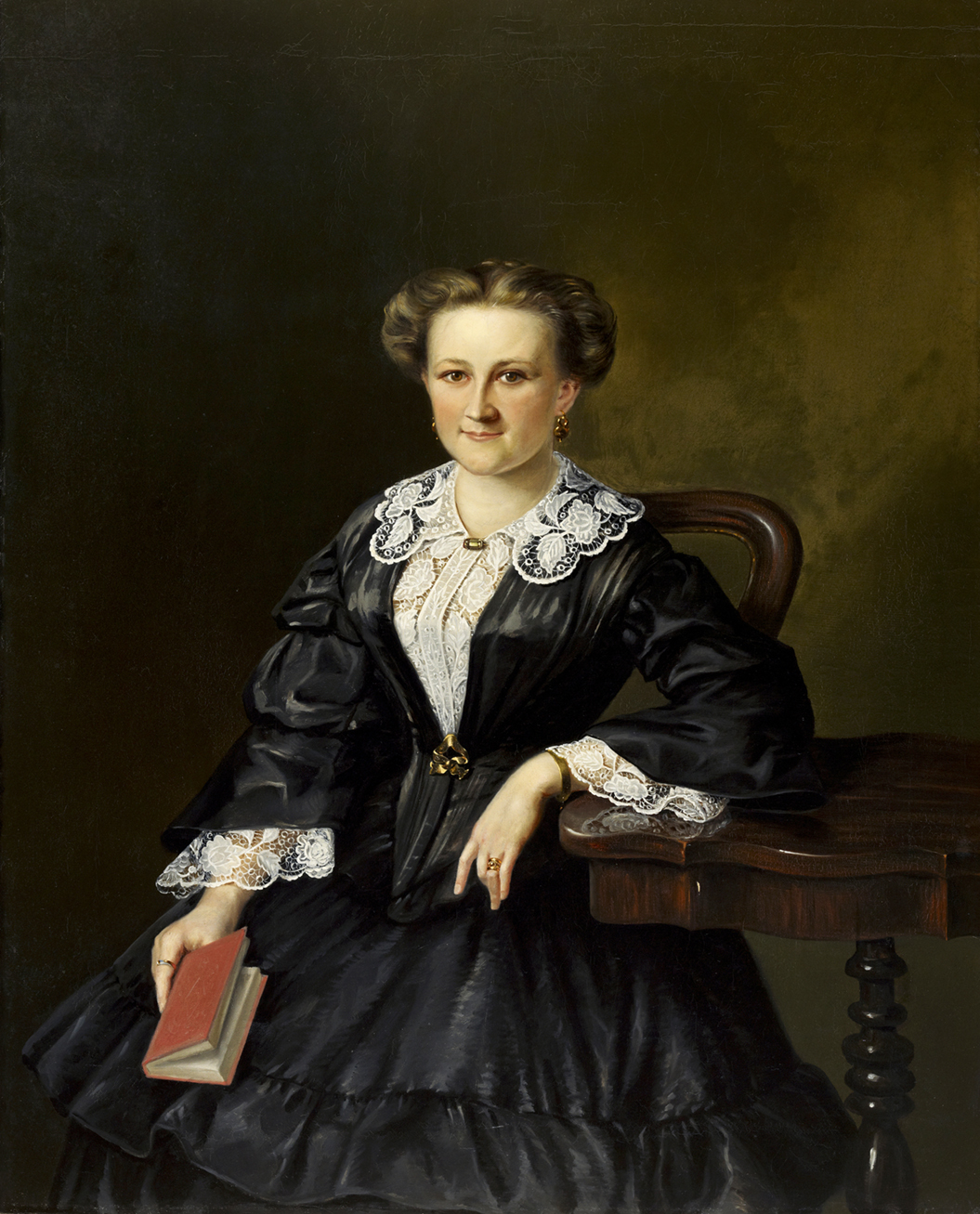
The empathetic Anna Sinebrychoff
At the turn of the century, brewing industry operations are hindered by continuous tax increases and increasingly stringent sales regulations. Countryside breweries are particularly hard hit. Sinebrychoff nevertheless has the resources for new investments; a modern bottle washer and a bottling machine are acquired from Denmark in 1902.
As a consequence of the new mechanised efficiency, approximately 20 women employed as bottle washers are given notice, but the majority shareholder Anna Sinebrychoff ensures that they do not experience financial hardship; the older women receive pensions and others extra severance pay.
Aiming at consistent quality
The brewmaster Georg Dürr joins Sinebrychoff on 20 May 1886. He was born on 22 October 1845 in the Pomeranian village of Reichenbach. Dürr heads brewing at Sinebrychoff until 1897. Before the turn of the century he moves to Germany where he dies in Nuremberg in late 1903.
Under Dürr’s leadership, a pure-cultured yeast is adopted at the brewery. Essential for achieving uniform quality in brews, the yeast is developed in 1883 by Emil Christian Hansen, a Danish chemist working at the Carlsberg laboratory in Copenhagen.
The counterfeit cork gang
In August 1892 what is perhaps the first trademark infringement case in Finland is heard in the Helsinki District Court, where the parties are Sinebrychoff and, summoned by the public prosecutor, two beer horsemen, a beer trader, and the property manager of the Nya Aktiebryggeri.
The trader had furnished Nya Aktiebryggeri’s beer bottles with Sinebrychoff’s corks received from the beer horseman in on the scheme, and sold over a hundred crates of the falsely labelled products. The court completely exonerates the property manager of Nya Aktiebryggeri. For one of the horsemen, the charges are unsubstantiated, but the other horseman and the trader are ordered to pay damages and fines. Instead of paying the fines, the convicted offenders serve 16-day prison sentences on a bread and water diet.
The case gives rise to – as is typical at the time – a series of claims and counterclaims in the press that begins when the property manager of Nya Aktiebryggeri takes offense at the court deposition presented by Sinebrychoff’s lawyer.
A few years later Sinebrychoff becomes the sole owner of the Nya Aktiebryggeri, situated along Albertinkatu in the Kamppi district of Helsinki.
Several junior brewmasters hired to facilitate the daily management of the brewery appear in the brewery’s accounts in the 1880s. Already in Stiastny’s time this role was assumed by Josef Volkmer, born 5 August 1853 in Mittelwald. In the brewery block’s personnel register, Adolf Steinmetz, born 10 July 1849 in Berlin, as well as Adolf Hübner, born 14 August 1859 in Berlin, are also listed as brewmaster Dürr’s subordinates. There are also Finnish supervisors, such as Samuel Mähönen, who first joined Sinebrychoff in 1863 as a 19-year-old workman but whose career at Hietalahti would eventually span over half a century.
In 1891, the Hietalahti brewery’s equipment is again renewed. The existing kettles installed in 1874 are sold to a firm in Sweden, and a state-of-the-art chemical apparatus – cooling technology that will transform brewing worldwide – is acquired. Logistics are handled by horses kept at a 60-horse stable in the brewery area. The city has already grown around and past the brewery area; in 1900 an electric tramline begins traffic to Hietalahti.

1894
In 1894 the Hietalahti brewery has 230 employees and two steam engines. New warehouse buildings are erected and additional space is quarried out of the on-site bedrock in 1897. The “Nicolai” cellars are higher than those excavated 20 years earlier; what is already the largest brewery in Finland gains even more capacity. Sinebrychoff’s market share of the entire beer market in Finland is approximately 25 %.
The next brewmaster Louis Carl Gustav Hebel is employed at Sinebrychoff at the turn of the century. He begins his employment in Hietalahti on 15 August 1898.
All, however, is not going as well as it should. In April 1900 a fire breaks out in the brewery office, where according to a news article “brewery books and some of the equipment used by brewmaster Louis Hebel were damaged, as well as the room itself” (Uusi Suometar 12th April 1900).
Hebel’s employment ends on 26 March 1902. The cause stated in the personnel register is “sjuklighet” (“sickliness”). Born in Stockholm on 25 August 1869, Hebel is listed as a German citizen. He dies in Stockholm in the autumn of 1905.

Anna Sinebrychoff dies in early 1904 shortly after Hebel’s departure; her son Paul continues as managing director and majority shareholder.

Scientific product development
Josef Frans Albin Amberger is a Swedish citizen, but comes from a Bavarian brewery family. Albin was born in Umeå on 26 February 1874. His father, the brewmaster Josef Amberger, dies in November 1877 and his uncle Frans, also a brewmaster, adopts the boy as his foster child in Gävle.
Albin gravitates towards brewing even at a young age. In the early 1890s he is practising in Germany and Bohemia, and in 1893 he studies at the Worms Lehmansche Brauerschule to become a diploma brewer. He works in large breweries in Dortmund for a few years while gaining additional expertise at the Alfred Jörgensen laboratory in Copenhagen before returning to the Gefle Ångbryggeri in Gävle. His next employment is in Finland.

On 19 September 1899 Albin Amberger joins Sinebrychoff as a malt master. He is employed at Sinebrychoff until his death on 13 May 1945. During this time Paul Sinebrychoff the Younger dies childless on 19 November 1917. Subsequently Axel Fredrik Hornborg, the son-in-law of Paul’s sister Anna, is elected Chairman and Managing Director.
The career of the young Amberger – almost baby-faced but obviously qualified – advances rapidly. In 1901 he is junior brewmaster; by 1902 he becomes the brewmaster responsible for running the Sinebrychoff brewery. The teachings from Copenhagen are effective; in 1908 he establishes Finland’s first fully-equipped brewery laboratory in Hietalahti.

The Swedish brewery chemist Sven Gustaf Axel Robert Berg is the first head of the laboratory. In 1913, Berg moves to Vaasa to become brewmaster at the local Bock brewery; from 1914 until late 1919 the Danish engineer Henry Suemsen-Meyer is in charge of the laboratory.
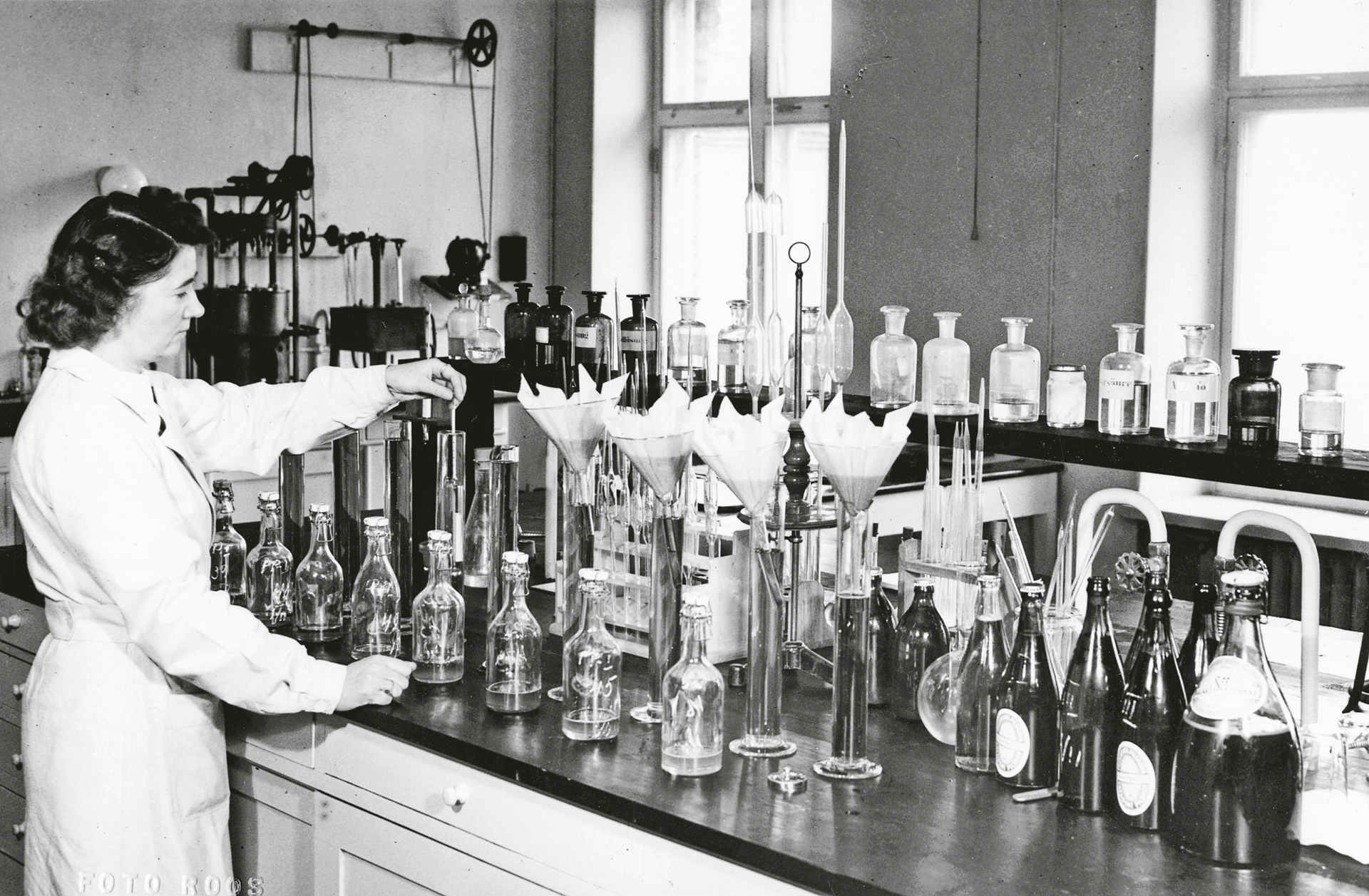
Lobbying with laboratory results
The Brewery Association cites Amberger’s conclusions when attempting to convince authorities that the allowable alcohol content of brews should be increased.
Albin Amberger becomes Technical Director in 1910. Holding several positions of trust, he guides Sinebrychoff’s brewing operations through the most tumultuous period in the history of the company. World War I breaks out. Finland gains its independence but is ravaged by a civil war. After peace is restored, a Prohibition Act on alcoholic beverages goes into effect.
During Prohibition, Amberger also studies the effects of alcohol on the storage life of beer. The Brewery Association cites his conclusions when attempting to convince the authorities that the allowable alcohol content of brews should be increased. In the 1920s Amberger also initiates a project that improves the quality of Finnish malt barley.
During 1928-1939 Sinebrychoff is still the largest brewery in Finland. In 1928 it produces 3.4 million litres of mild brews compared to the entire country’s production of approximately 40 million litres.
After Prohibition ends, Sinebrychoff’s production outpaces that of its competitors. In 1939, sales measured in litres pass the 10-million-litre milestone for the first time. The consumption of strong beers is still less than 40 million litres when World War II reaches Finland.
Detrimental raw materials shortages
During World War I there is a continuous shortage of raw materials for beer, which after the war become even more difficult to procure. Amberger himself later writes that the years 1918–1919 were the most difficult: “Hopefully we will never need to make such poor quality brews again.” Brewery accounts indicate that there is little barley and it is extended with oats. The pitching wort concentration is at its lowest only 2%.
From Hietalahti to Kerava
1940–2018
Masters from Copenhagen
During World War II, Albin Amberger still heads the Sinebrychoff brewery’s production operations. By then he has several brewmaster colleagues who have graduated from the Den Skandinaviske Bryggerihøjskole (SBH) in Copenhagen and who are employed during the 1930s.
Ragnar Bäck is the first Finnish brewmaster graduating from SBH (1930). He works in the Sinebrychoff laboratory as a chemist from the time of his graduation and he actively participates in the development of Finnish malt barley. In 1945 he takes a new job in Vaasa at the Bock brewery.
Helge Helin graduates as brewmaster from SBH in 1935. During 1936-37 he works at the Yhdysoluttehdas in Viborg, after which he joins Sinebrychoff as a brewmaster. When Amberger falls ill during the war, Helin oversees Hietalahti’s beverage production. By the time he finishes his work at Sinebrychoff in 1958, he is a Senior Brewmaster.

How long will the oats last?
At the onset of the Winter War in 1939–40, there is no shortage of brewing barley, but as the hostilities continue, the availability of supplies deteriorates, and the production of excise class III beer for domestic use ends in the summer of 1942. Strong beer is still brewed for the German troops in the country from their own malts.
Russian bombers inflict only minor damage on the Hietalahti brewery during the war. The brewery is fortunate; the University of Technology across the street is badly damaged, and several wooden residences along Punavuorenkatu are destroyed.
Rationing continues after peace is restored, but by 1948 the sufficiency of grain allows the government to authorise the production of excise class III beer. The annual output of Sinebrychoff’s brewery increases to 16.9 million litres.
A shortage of everything
After the war, there are still many years of severe rationing. There is shortage of everything, from hay for the horses to the rubber gloves and boots used by brewery employees.
In 1950 the Sinebrychoff brewery’s annual output passes the 20 million litre milestone, and further increases to 23.3 million litres in 1955. That year Sinebrychoff begins to produce soft drinks; the first year’s production is 2.4 million litres.
Class A beer launched
In 1950 the government monopoly (Alkoholiliike) that controls and regulates the production of alcoholic beverages in Finland allows Sinebrychoff and a few other breweries to produce and sell a few trial batches of an even stronger brew. The trial is deemed successful, and in 1953 Alko authorises eleven breweries to produce this so-called “A Beer” and sell it in their own sales regions. Eventually “A Beer” is sold in all parts of the country beginning in 1955.
Birth of a classic
Nils Sandman studies at the Copenhagen SBH during World War II and graduates as a brewmaster in 1943. He works at Sinebrychoff during 1944–1979 as Brewmaster, Senior Brewmaster, and Technical Director.

1957
In 1957, Sandman, Boris Orlo, and Laboratory Manager Aarne Rahiala collaborate to develop Sinebrychoff Porter, which is still produced today.
Orlo graduates as brewmaster from the SBH in 1948. He develops his expertise at Heineken in Holland and then at the Guinness and Courage breweries in London. Orlo works at Sinebrychoff as brewmaster during 1949–1970 with responsibilities that include filling; subsequently he moves to the Aura brewery in Turku.
Rahiala is employed as Sinebrychoff’s laboratory manager during 1945–1977. Before joining Sinebrychoff he works at the Ministry of Health and Human Services where he develops brewery accounting and quality control processes.
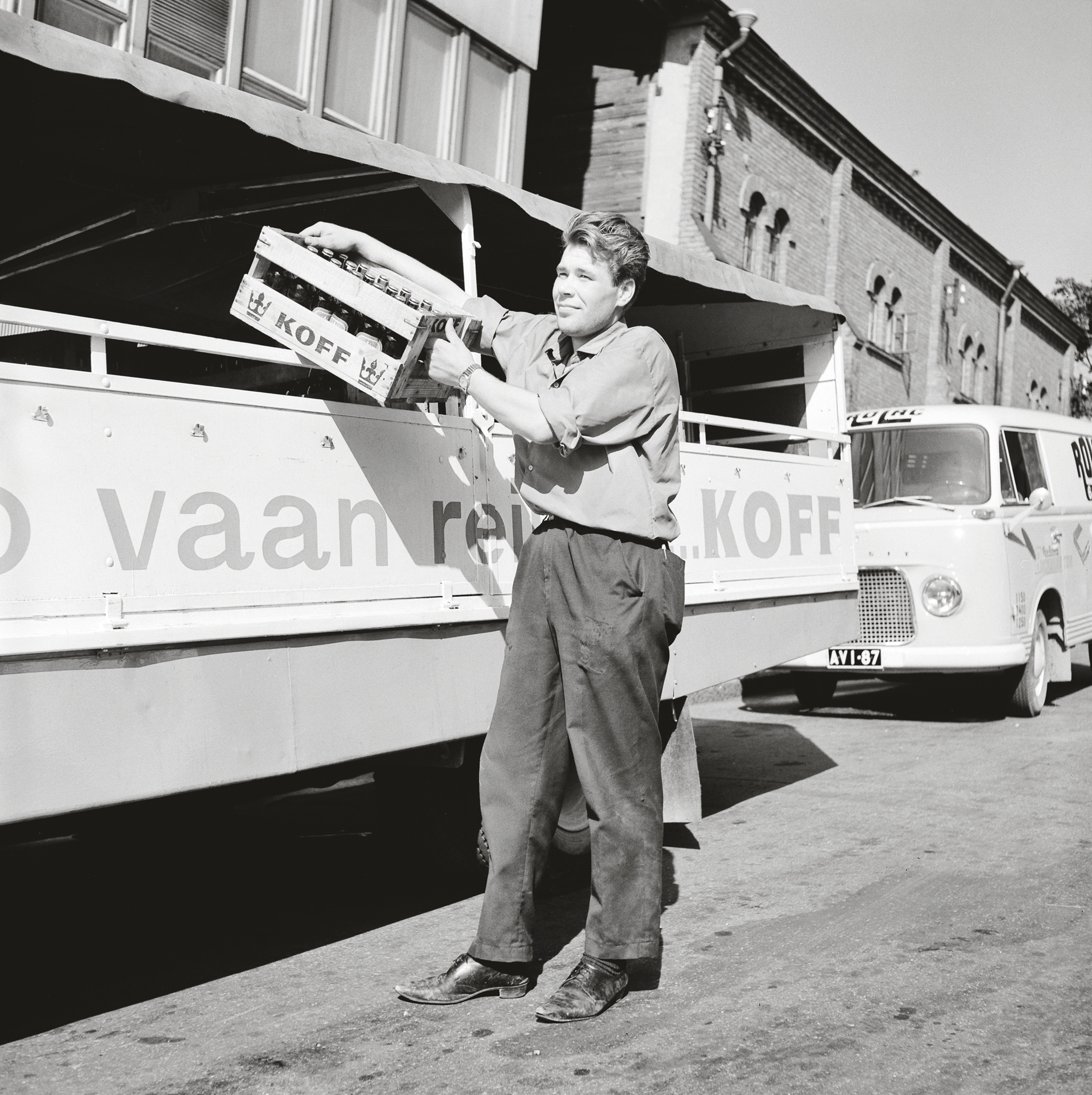
Class III beer enters grocery stores
Alcohol legislation is revised in the 1960s to also allow the retail sales of excise class III beer in other outlets besides the state monopoly’s own stores. This means a period of expansion for breweries; a new kettle room is built at Hietalahti.
Finnish Heritage Agency Photo Archives
Towards Kerava
Bo Segersven graduates as a brewmaster from the Versuchs- und Lehranstalt für Brauerei (VLB) in Berlin in 1967. He works at Sinebrychoff from 1966 onwards, as a brewmaster until 1981 and as the Helsinki brewery manager until 1992. Subsequently he is employed as the property manager for Sinebrychoff’s Kerava brewery, and as a project consultant in, for example, the Vena project. Segersven is the last Sinebrychoff brewmaster to reside on the Hietalahti brewery plot.
Kimmo Jääskeläinen joins Sinebrychoff as a process engineer in 1973. He becomes laboratory manager in 1977 and production manager in 1982. Holding a Master of Science in Engineering degree, Jääskeläinen leads the Kerava project as a project manager during 1990-1992, after which he then works as a production manager and manufacturing manager until 2001. During 2001-2006 he is Technical Director, and 2006-2012 again Production Director.
Esko Pajunen joins Sinebrychoff in 1979 as a Research and Development Manager. Pajunen, also holding a Master of Science in Engineering degree, has previously worked in the biotechnology laboratory at the Technical Research Centre of Finland (VTT) as researcher and manager. In 1987 he is named Production Director at Sinebrychoff, and in 1993 he becomes Development Director. During 2006-2009 he is the Director of the Carlsberg Research Center. Highly esteemed internationally, Pajunen also serves for several years as the President of the European Brewers Convention at the change of century.
In 1972 Sinebrychoff acquires the Pori Oluttehdas brewery in Pori.
Georg Orlow graduates as brewmaster from the VLB in Berlin in 1953. He first joins the Loimaa Oluttehdas as a brewmaster. In 1966 he becomes the production manager at the Pori Oluttehdas; Orlow retires from Pori in 1987.
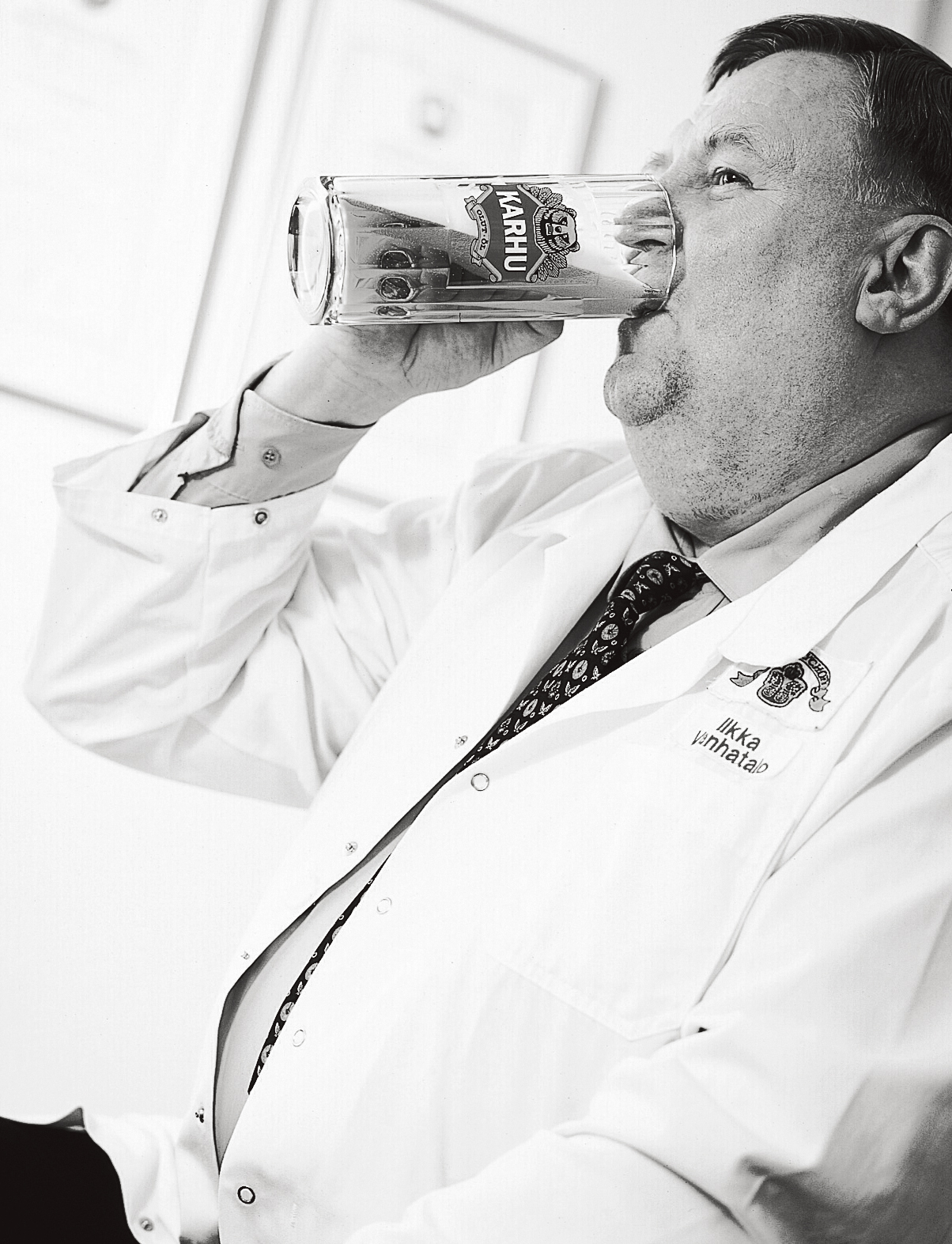
Investments brought new brewmasters
In 1972 Sinebrychoff buys Pori brewery, where Ilkka Vanhatalo worked also as a production manager.
Ilkka Vanhatalo graduates as a brewmaster from the SBH in Copenhagen in 1988. He is production manager in Pori during 1984–2002 and thereafter works as project engineer. In 2008 Vanhatalo moves to the Nokia brewery.
Jari Väänänen graduates as a brewmaster from the SBH. He is brewery manager in Pori during 2005–2009 and works thereafter at Sinebrychoff’s Kerava brewery until late 2010.
Sinebrychoff acquires the Pyynikki brewery in Tampere in 1985.
Paul Dill graduates as brewmaster from the Doemens Akademie in Munich in 1957. He works as brewmaster at the Pyynikki brewery until 1987.
Wolfgang Paulus graduates in 1960 as brewmaster from the Technische Hochschule München Weihenstephan (Munich University of Applied Sciences). He is responsible for production at the Pyynikki brewery during 1988-1992 and works thereafter at Sinebrychoff’s Kerava brewery until 1997.
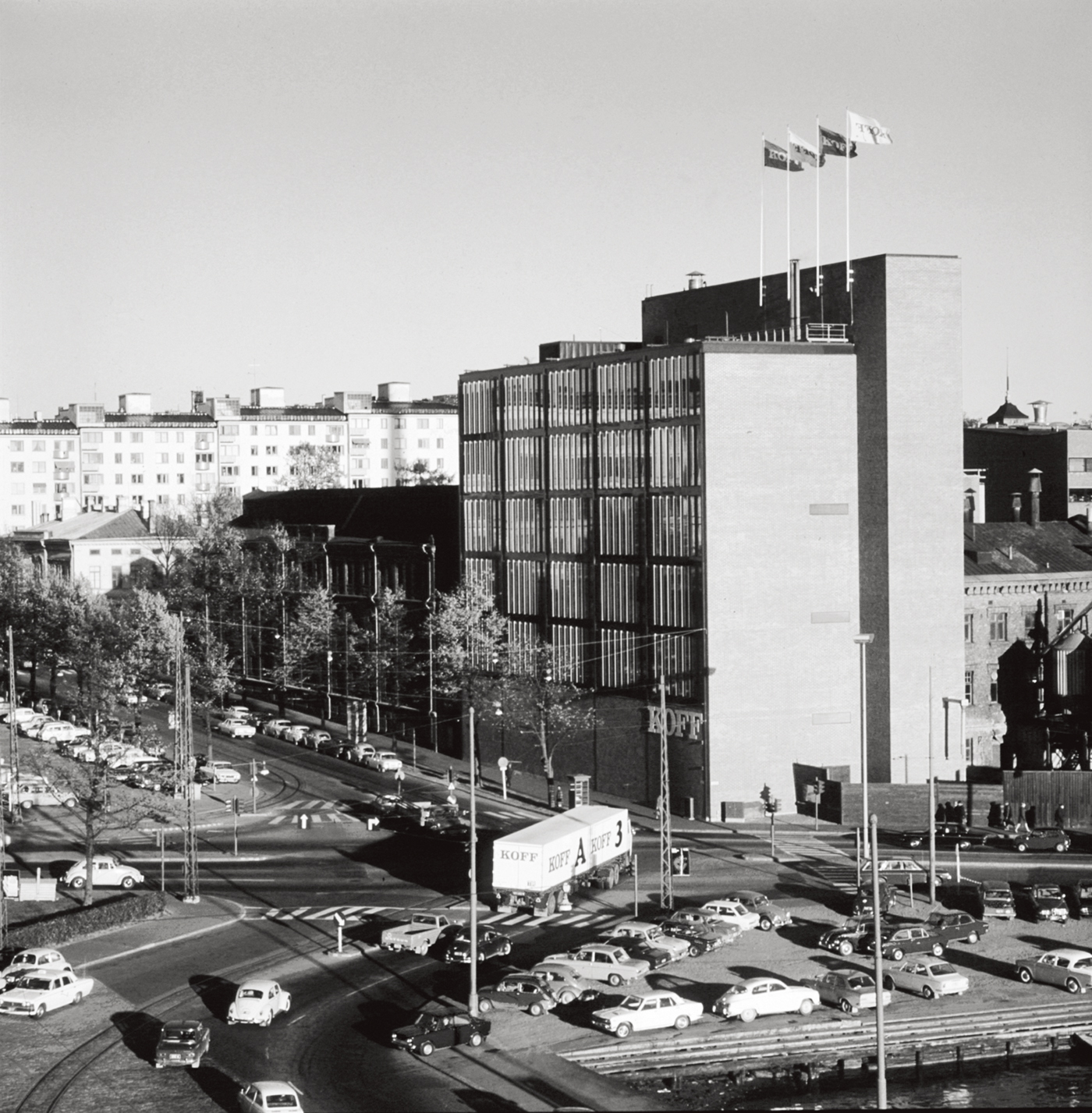
Success calls for more space
Between 1968 and 1992, beer production is doubled at the Sinebrychoff brewery, and the premises become too cramped. There are no expansion possibilities in Hietalahti; a new brewery is built in Kerava.
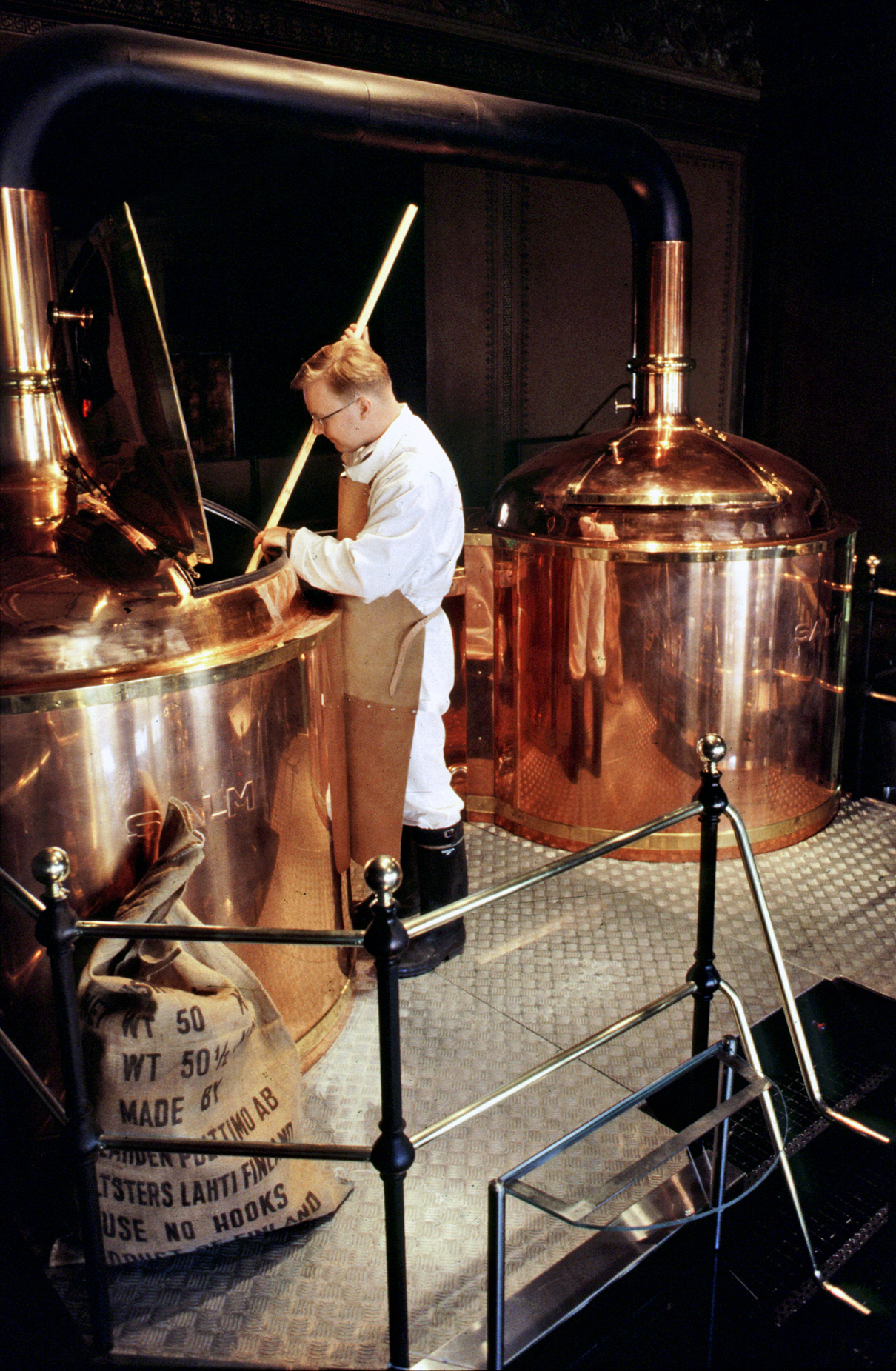
Kappeli
The first bottles clatter on Kerava brewery bottling line in January. During the same year, a microbrewery managed by Sinebrychoff is launched at the Kappeli restaurant in downtown Helsinki; its operations are discontinued in 2000.
Sinebrychoff’s brewmasters today
2019 ->
Sinebrychoff’s brewmasters today
Bo Ranta graduated as a brewmaster from the Copenhagen SBH in 1993 after working at Sinebrychoff since 1988. During 1993–2002 he worked as a brewmaster at the Kerava brewery before his transfer to the Pori brewery as a local director. In 2005-2006 he worked at the Carlsberg brewery in Malaysia, in 2007 he returned to Kerava, and in 2008-2010 he was the Production Director at Carlsberg, Sweden. Ranta returned to Kerava in 2010 as the brewery’s Production Director. He retired from Sinebrychoff in 2020.
Tapio Kangas-Heiska graduated in 1996 as a brewmaster from the Doemens Akademie in Munich. Before his studies he had already worked at Sinebrychoff for several years. During 1996-2002 he was a brewmaster at the Kerava brewery. From 2002 onwards he has been responsible for Sinebrychoff’s beverage production. He retired from Sinebrychoff in 2021.
Rainer Kiiskilä began his career at the Pyynikki brewery, and was later responsible for the kettle room at Sinebrychoff’s Kerava brewery during 1992-2018. In 1997 he graduated from the Siebel Institute of Technology’s brewmaster program in Chicago. He retired from Sinebrychoff in 2018.
Harry Berg was responsible for production in the Kappeli microbrewery in Helsinki during 1993–2000, after which he was transferred to Sinebrychoff’s Kerava brewery. From 2002 onwards, he has been responsible for the beer process and graduated as a brewmaster from the SBH in 2009.
Paula Hantula joined the Kerava brewery in 2003 and graduated as a brewmaster from the SBH in 2007. She worked as junior brewmaster in the beer process during 2008-2015.
Heikki Vuokko joined Sinebrychoff in 2007. He graduated as a brewmaster from the SBH in 2017. Since 2018, he has been responsible for the brewing process in the Kerava brewery. After Tapio Kangas-Heiska retired in 2021, Heikki Vuokko has been responsible for Sinebrychoff’s beverage production and is the acting Head Brewmaster.

The continuous expansion and development of modern brewing places demands on brewmasters’ skills other than brewing: filling, product development, and quality control. In recent years, Anders Grönqvist, Mika Huttunen, Saara Pöyri, Rauno Sillanpää, Piia Soininen-Tengvall and Hanna TalviOja have significantly contributed to the development of Sinebrychoff, the oldest brewery in the Nordic Countries.
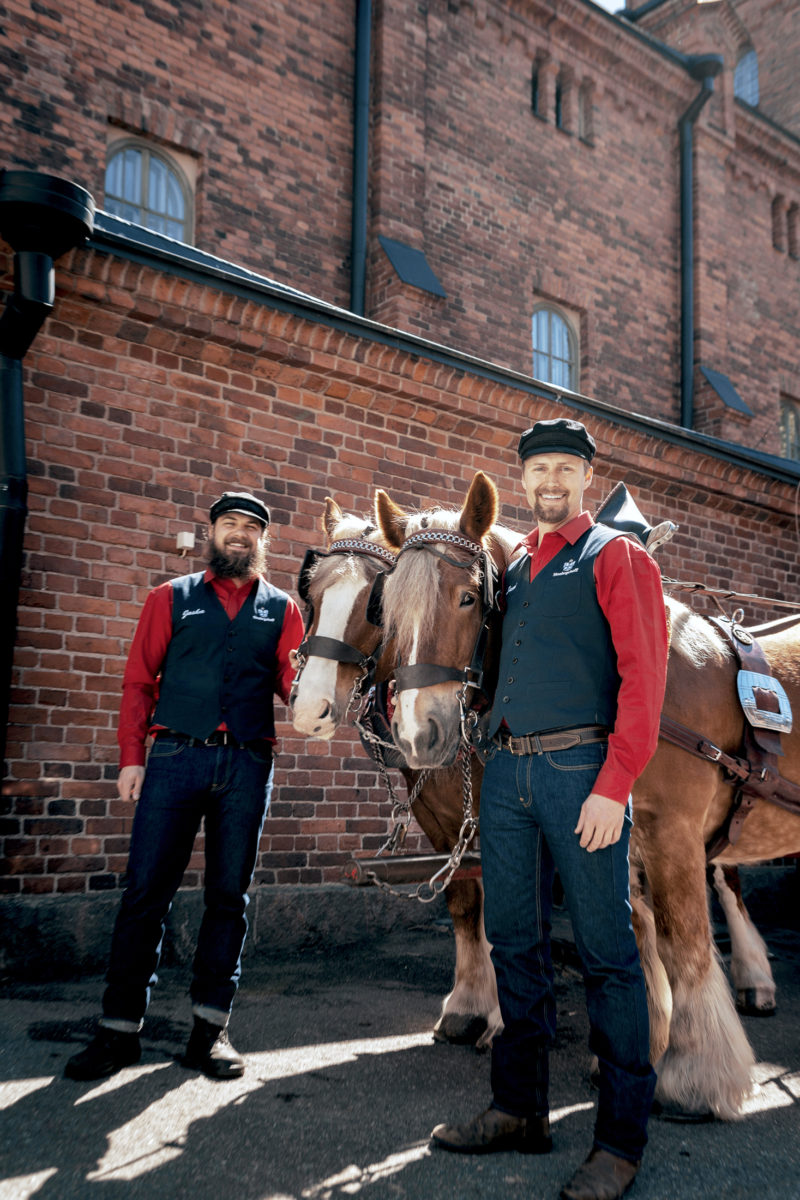
Hietalahti today
Some buildings from the original Sinebrychoff brewery are still standing on Sinebrychoff’s old Hietalahti site in Helsinki: a wooden house erected in the early 1820s, a former fermentation cellar that has been renamed the Kiltakellari, and the stables from where brewery horses still pull carriages in downtown Helsinki and at summer events around the country. The stone building along Bulevardi is now The Sinebrychoff Art Museum housing the art collection donated to the state of Finland by Paul Sinebrychoff the Younger and his wife Fanny.
The brewmasters of Sinebrychoff according to the year they joined the company
- Christian Friedrich Eichstedt
1819–48 - August Putzscher
1820-28 - Reinhold Wennberg
1822–25 - Gottfried Putzscher
1826–30 - Carl Preis
1830–33 - W. Nachtigall
1835–45 - Erik Gustav Nilsson
1843–52 - Adam Julius Adolf Arenander
1848–53 - Johann Kasper Kröckel
1853–64 - Johann Leonard Zorn
1863–72 - Heinrich Lehmann
1873–74 - Michael Schick
1874–79 - Robert Büchner
1879–82 - Anton Stiastny
1882–86 - Georg Dürr
1886–97 - Louis Carl Gustav Hebel
1898–1902 - Josef Frans Albin Amberger
1899–1945 - Ragnar Bäck
1930–45 - Helge Helin
1937–58 - Nils Sandman
1944–79 - Boris Orlo
1949–70 - Bo Segersven
1966–2005 - Georg Orlow
1966–87 - Paul Dill
1967–87 - Kimmo Jääskeläinen
1973–2012 - Esko Pajunen
1979–2009 - Ilkka Vanhatalo
1984–2002 - Rainer Kiiskilä
1985–2018 - Tapio Kangas-Heiska
1985–2021 - Wolfgang Paulus
1988–97 - Bo Ranta
1988–2020 - Rauno Sillanpää
1989–2023 - Harry Berg
1992– - Paula Hantula
2003– - Jari Väänänen
2005–09 - Heikki Vuokko
2007–
